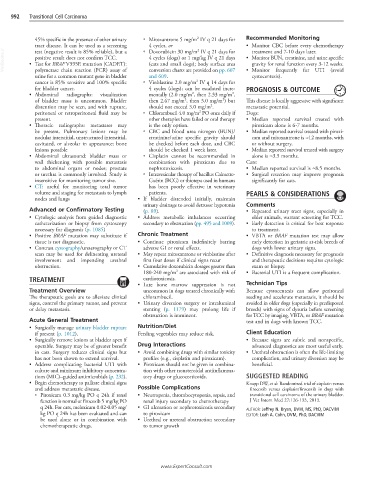Page 1982 - Cote clinical veterinary advisor dogs and cats 4th
P. 1982
992 Transitional Cell Carcinoma
2
45% specific in the presence of other urinary ○ Mitoxantrone 5 mg/m IV q 21 days for Recommended Monitoring
tract disease. It can be used as a screening ○ Doxorubicin 30 mg/m IV q 21 days for • Monitor CBC before every chemotherapy
4 cycles, or
2
VetBooks.ir • Test for BRAF V595E mutation (CADET): 4 cycles (dogs) or 1 mg/kg IV q 21 days • Monitor BUN, creatinine, and urine specific
test (negative result is 85% reliable), but a
treatment and 7-10 days later.
positive result does not confirm TCC.
gravity for renal function every 3-12 weeks.
(cats and small dogs); body surface area
polymerase chain reaction (PCR) assay of
cystocentesis).
urine for a common mutant gene in bladder conversion charts are provided on pp. 607 • Monitor frequently for UTI (avoid
and 609.
2
cancer is 85% sensitive and 100% specific ○ Vinblastine 2.0 mg/m IV q 14 days for
for bladder cancer. 4 cycles (dogs); can be escalated incre- PROGNOSIS & OUTCOME
2
2
• Abdominal radiographs: visualization mentally (2.0 mg/m , then 2.33 mg/m ,
2
2
of bladder mass is uncommon. Bladder then 2.67 mg/m , then 3.0 mg/m ) but This disease is locally aggressive with significant
2
distention may be seen, and with rupture, should not exceed 3.0 mg/m . metastatic potential.
2
peritoneal or retroperitoneal fluid may be ○ Chlorambucil 4.0 mg/m PO once daily if Dogs:
present. other therapies have failed or oral therapy • Median reported survival treated with
• Thoracic radiographs: metastases may is the only option. piroxicam alone is 6-7 months.
be present. Pulmonary lesions may be ○ CBC and blood urea nitrogen (BUN)/ • Median reported survival treated with piroxi-
nodular interstitial, unstructured interstitial, creatinine/urine specific gravity should cam and mitoxantrone is ≈12 months, with
cavitated, or alveolar in appearance; bone be checked before each dose, and CBC or without surgery.
lesions possible should be checked 1 week later. • Median reported survival treated with surgery
• Abdominal ultrasound: bladder mass or ○ Cisplatin cannot be recommended in alone is ≈3.5 months.
wall thickening with possible metastasis combination with piroxicam due to Cats:
to abdominal organs or nodes; prostate nephrotoxicosis. • Median reported survival is ≈8.5 months.
or urethra is commonly involved. Study is ○ Intravesicular therapy of bacillus Calmette- • Surgical resection may improve prognosis
insensitive for monitoring tumor size. Guérin (BCG) or thiotepa used in humans significantly for cats.
• CT: useful for monitoring total tumor has been poorly effective in veterinary
volume and staging for metastasis to lymph patients. PEARLS & CONSIDERATIONS
nodes and lungs • If bladder distended initially, maintain
urinary drainage to avoid detrusor hypotonia Comments
Advanced or Confirmatory Testing (p. 89). • Repeated urinary tract signs, especially in
• Cytologic analysis from guided diagnostic • Address metabolic imbalances occurring older animals, warrant screening for TCC.
catheterization or biopsy from cystoscopy secondary to obstruction (pp. 495 and 1009). • Early detection is critical for best response
necessary for diagnosis (p. 1085) to treatment.
• Positive BRAF mutation may substitute if Chronic Treatment • VBTA or BRAF mutation test may allow
tissue is not diagnostic. • Continue piroxicam indefinitely barring early detection in geriatric at-risk breeds of
• Contrast cystography/ureterography or CT adverse GI or renal effects. dogs with lower urinary signs.
scan may be used for delineating ureteral • May repeat mitoxantrone or vinblastine after • Definitive diagnosis necessary for prognosis
involvement and impending urethral first four doses if clinical signs recur and therapeutic decisions requires cytologic
obstruction. • Cumulative doxorubicin dosages greater than exam or biopsy.
2
180-240 mg/m are associated with risk of • Bacterial UTI is a frequent complication.
TREATMENT cardiotoxicosis.
• Late bone marrow suppression is not Technician Tips
Treatment Overview uncommon in dogs treated chronically with Because cystocentesis can allow peritoneal
The therapeutic goals are to alleviate clinical chlorambucil. seeding and accelerate metastasis, it should be
signs, control the primary tumor, and prevent • Urinary diversion surgery or intraluminal avoided in older dogs (especially in predisposed
or delay metastasis. stenting (p. 1179) may prolong life if breeds) with signs of dysuria before screening
obstruction is imminent. for TCC by imaging, VBTA, or BRAF mutation
Acute General Treatment test and in dogs with known TCC.
• Surgically manage urinary bladder rupture Nutrition/Diet
if present (p. 1012). Feeding vegetables may reduce risk. Client Education
• Surgically remove lesions at bladder apex if • Because signs are subtle and nonspecific,
operable. Surgery may be of greater benefit Drug Interactions advanced diagnostics are most useful early.
in cats. Surgery reduces clinical signs but • Avoid combining drugs with similar toxicity • Urethral obstruction is often the life-limiting
has not been shown to extend survival. profiles (e.g., cisplatin and piroxicam). complication, and urinary diversion may be
• Address complicating bacterial UTI with • Piroxicam should not be given in combina- beneficial.
culture and minimum inhibitory concentra- tion with other nonsteroidal antiinflamma-
tions (MIC)–guided antimicrobials (p. 232). tory drugs or glucocorticoids. SUGGESTED READING
• Begin chemotherapy to palliate clinical signs Knapp DW, et al: Randomized trial of cisplatin versus
and address metastatic disease. Possible Complications firocoxib versus cisplatin/firocoxib in dogs with
○ Piroxicam 0.3 mg/kg PO q 24h if renal • Neutropenia, thrombocytopenia, sepsis, and transitional cell carcinoma of the urinary bladder.
function is normal or firocoxib 5 mg/kg PO renal injury secondary to chemotherapy J Vet Intern Med 27:126-133, 2013.
q 24h. For cats, meloxicam 0.02-0.05 mg/ • GI ulceration or nephrotoxicosis secondary AUTHOR: Jeffrey N. Bryan, DVM, MS, PhD, DACVIM
kg PO q 24h has been evaluated and can to piroxicam EDITOR: Leah A. Cohn, DVM, PhD, DACVIM
be used alone or in combination with • Urethral or ureteral obstruction secondary
chemotherapeutic drugs. to tumor growth
www.ExpertConsult.com

